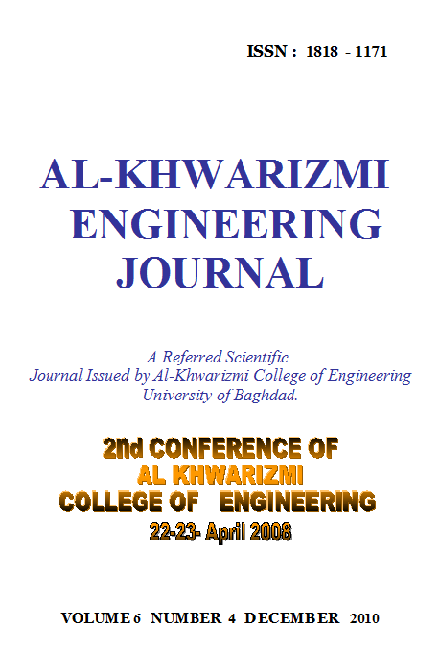Prediction of Equilibrium Mixing Index and Optimum Mixing Time for Three solid materials in Fluidized Column
Abstract
Equilibrium and rate of mixing of free flowing solid materials are found using gas fluidized bed. The solid materials were sand (size 0.7 mm), sugar (size0.7 mm) and 15% cast iron used as a tracer. The fluidizing gas was air with velocity ranged from 0.45-0.65 m/s while the mixing time was up to 10 minutes. The mixing index for each experiment was calculated by averaging the results of 10 samples taken from different radial and axial positions in fluidized QVF column 150 mm ID and 900 mm height.
The experimental results were used in solving a mathematical model of mixing rate and mixing index at an equilibrium proposed by Rose. The results show that mixing index increases with increasing air velocity and mixing time until it reaches an optimum value then decrease to an equilibrium value. The results also show the dependency of the mixing index on the particle size of the tracer component.
The statistical analysis of the obtained theoretical mixing index versus the experimental mixing index shows that the standard error is 0.92 % (about 1 %) with the correlation coefficient of 0.9857 and the total residual of 0.002 for the ninth observation of the mixing index (theoretical versus experimental) over 95% confidence level.
Downloads
References
[2] Boss, J., Knapik, A. T., Wegrzyn, M. and Poland, W. M.," Segregation of heterogeneous grain systems during mixing in static mixers", Bulk Solid Handling, 6, 145 (1986).
[3] Clyde, O.Jr. , “Particulate technology”, The Macmillan company, New York, (1966).
[4] Davidson, J. F. and Harrison, D., “Fluidization”, Academic Press, London and New York, (1971).
[5] Fan, L.T., Gleves-Arocha, H.H., Walawender, W.P. and Lai, F.S.,” A mechanistic kinetic model of the rate of mixing segregation solid particles”, Powder Technology, 12, 139-156(1975).
[6] Fan, L.T. and Wang, R.H., "On Mixing indices", Powder Technology, 11, 27-32(1975).
[7] Hoffman, A.C., Janssen, L.P.B.M. and Prins, J.," Introduction to fluidization", Chem. Eng. Science, vol. 48, No. 9, 1583-1592, (1993).
[8] Kunii, D.and Levenspiel, O., Fluidization Engineering, 2nd edition, Butterworth-Heine mann, Stonham, 1991.
[9] Nokazi, A. and Behaviormetrika, “A mixing index based on a Markov model”, No.7, 61-74 (1980).
[10] Perry, J.H., “Chemical engineer’s handbook”, 5th edition, McGraw Hill, New York, (1984).
[11] Rasha, H.S., 2007, "A Quantitative Analysis Of The Mixing Of Solids Different In Density By An Air Fluidized Bed", M.Sc. Thesis, Chem. Eng. Dept., Collage of Eng., University of Baghdad.
[12] Rose, H.E.," A suggested equation related to the mixing of powders", Trans. Inst. Chem. Engrs., 37, 47 (1959).
[13] Roseman, B. and Donald, M.B.,"Effects of varying the operating conditions of a horizontal drum mixers", British Chemical Engineering Journal, vol. 7, No.11, 823-826(1962).
[14] Scarlett, B.,”Mixing”, Chem. Process Eng., 612 (1964).
[15] Spiegel, M. R.," statistics", Schonm’s Outline Series, McGraw Hill Book Co. Ltd., (1972).
[16] Vaizoglu, O., “Assessment of the degree of mix of powder characterization of dispersive and distributive mixing in a single screw extruder”, Tr.J. Physics, 23, 94-104(1999).
Published
Issue
Section
License
Copyright: Open Access authors retain the copyrights of their papers, and all open access articles are distributed under the terms of the Creative Commons Attribution License, which permits unrestricted use, distribution, and reproduction in any medium, provided that the original work is properly cited. The use of general descriptive names, trade names, trademarks, and so forth in this publication, even if not specifically identified, does not imply that these names are not protected by the relevant laws and regulations. While the advice and information in this journal are believed to be true and accurate on the date of its going to press, neither the authors, the editors, nor the publisher can accept any legal responsibility for any errors or omissions that may be made. The publisher makes no warranty, express or implied, with respect to the material contained herein.












